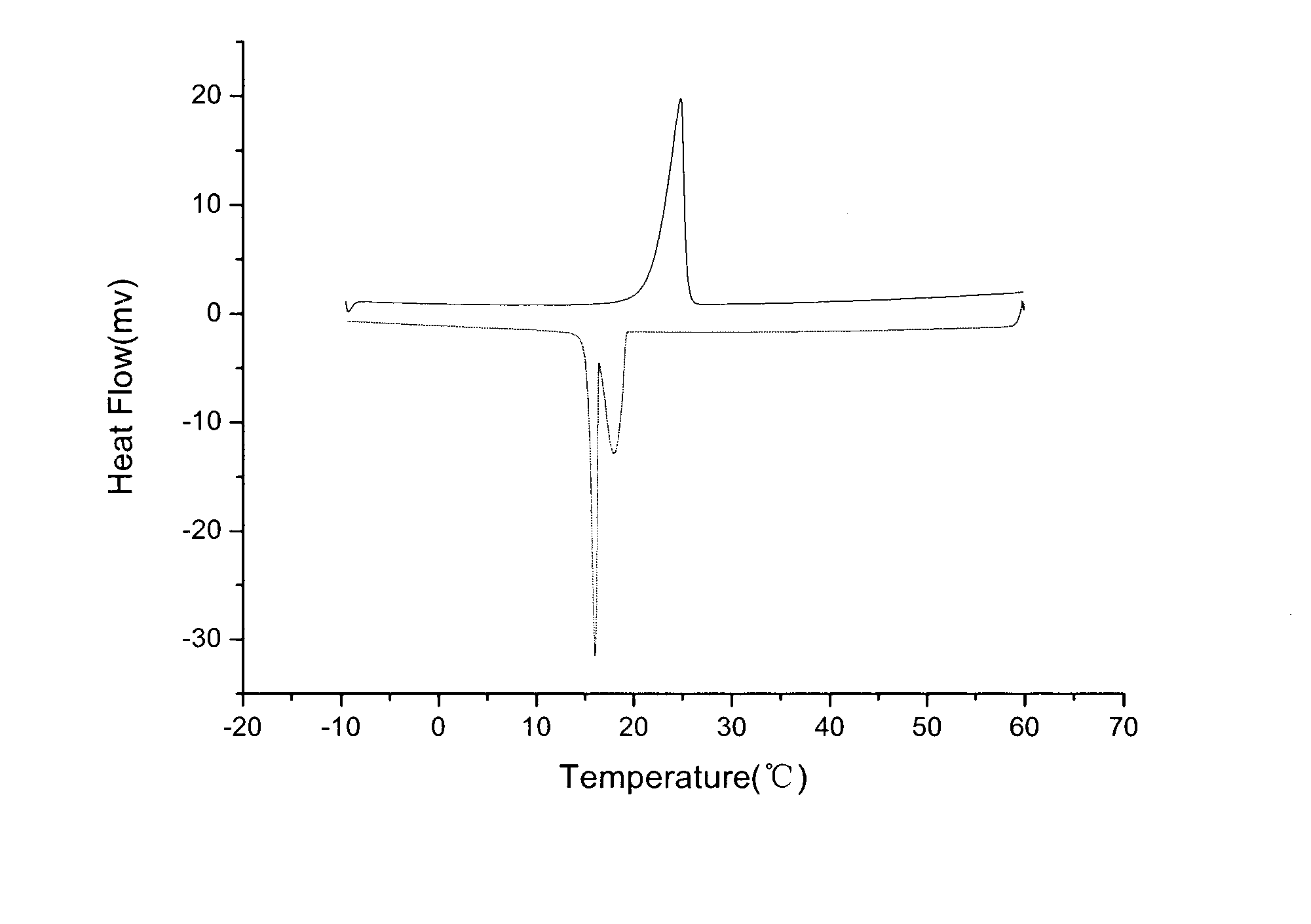Phase change energy storage microcapsule material and its preparation method
A phase-change energy storage and phase-change material technology, which is applied in the field of phase-change energy storage microcapsule materials and their preparation, can solve problems such as affecting the environment and human health, volatile formaldehyde, and restricting the application of phase-change materials, and achieves compactness. Excellent, fast reaction speed, high yield effect
- Summary
- Abstract
- Description
- Claims
- Application Information
AI Technical Summary
Problems solved by technology
Method used
Image
Examples
Embodiment 1
[0021] Step 1, weigh 10 g of n-dodecyl alcohol, 4 g of methyl methacrylate, 1 g of acrylic acid, 0.4 g of Span-60, 0.6 g of Tween-80, 0.05 g of azobisisobutyronitrile, and 100 g of deionized water;
[0022] Step 2: Add n-dodecyl alcohol to deionized water, add emulsifiers Span-60 and Tween-80, mix, stir evenly, heat to 65°C, and use ultrasonic emulsification for 10 minutes;
[0023] Step 3, after ultrasonic emulsification for 10 minutes, transfer the obtained mixture solution to a four-neck flask including mechanical stirring, condenser, nitrogen inlet and feeding port, heat in a water bath to 65°C, and mechanically stir for 20 minutes;
[0024] Step 4: Add methyl methacrylate to the solution in Step 3, pass nitrogen gas to deoxygenate for 0.5 h, heat in a water bath to 80°C, slowly add azobisisobutyronitrile to initiate polymerization of methyl methacrylate, and react at constant temperature for 2 h Finally, add acrylic acid, and continue to keep the water bath at 80°C for 3 ...
Embodiment 2
[0027] Step 1, weigh 5g of n-dodecyl alcohol, 4g of methyl methacrylate, 1g of acrylic acid, 1g of OP-10, 0.1g of potassium persulfate, and 100g of deionized water;
[0028] Step 2: Add n-dodecyl alcohol to deionized water, add emulsifier OP-10, mix, stir evenly, heat to 65°C, and use ultrasonic emulsification for 10 minutes;
[0029] Step 3, after ultrasonic emulsification for 10 minutes, transfer the obtained mixture solution to a four-neck flask including mechanical stirring, condenser, nitrogen inlet and feeding port, heat in a water bath to 65°C, and mechanically stir for 15 minutes;
[0030] Step 4: Add methyl methacrylate to the solution in Step 3, pass nitrogen gas to deoxygenate for 0.5 h, heat in a water bath to 80°C, slowly add potassium persulfate to initiate methyl methacrylate polymerization, react at constant temperature for 2 h, and then Add acrylic acid, and continue to keep the water bath at 80°C for 3 hours;
[0031] Step 5: After the polymerization reactio...
Embodiment 3
[0033] Step 1, weigh 15g of n-dodecyl alcohol, 4g of methyl methacrylate, 1g of acrylic acid, 0.4g of Span-60, 0.6g of Tween-80, 0.1g of ammonium persulfate, and 100g of deionized water;
[0034] Step 2: Add n-dodecyl alcohol to deionized water, add emulsifiers Span-60 and Tween-80, mix, stir evenly, heat to 65°C, and use ultrasonic emulsification for 10 minutes;
[0035] Step 3, after ultrasonic emulsification for 10 minutes, transfer the obtained mixture solution to a four-neck flask including mechanical stirring, condenser, nitrogen inlet and feeding port, heat in a water bath to 65°C, and mechanically stir for 10 minutes;
[0036] Step 4: Add methyl methacrylate to the solution in Step 3, pass nitrogen gas to deoxygenate for 0.5 h, heat in a water bath to 80°C, slowly add ammonium persulfate to initiate methyl methacrylate polymerization, react at constant temperature for 2 h, and then Add acrylic acid, and continue to keep the water bath at 80°C for 3 hours;
[0037] Ste...
PUM
| Property | Measurement | Unit |
|---|---|---|
| melting point | aaaaa | aaaaa |
| phase transition temperature | aaaaa | aaaaa |
| phase transition enthalpy | aaaaa | aaaaa |
Abstract
Description
Claims
Application Information
 Login to View More
Login to View More - R&D
- Intellectual Property
- Life Sciences
- Materials
- Tech Scout
- Unparalleled Data Quality
- Higher Quality Content
- 60% Fewer Hallucinations
Browse by: Latest US Patents, China's latest patents, Technical Efficacy Thesaurus, Application Domain, Technology Topic, Popular Technical Reports.
© 2025 PatSnap. All rights reserved.Legal|Privacy policy|Modern Slavery Act Transparency Statement|Sitemap|About US| Contact US: help@patsnap.com

